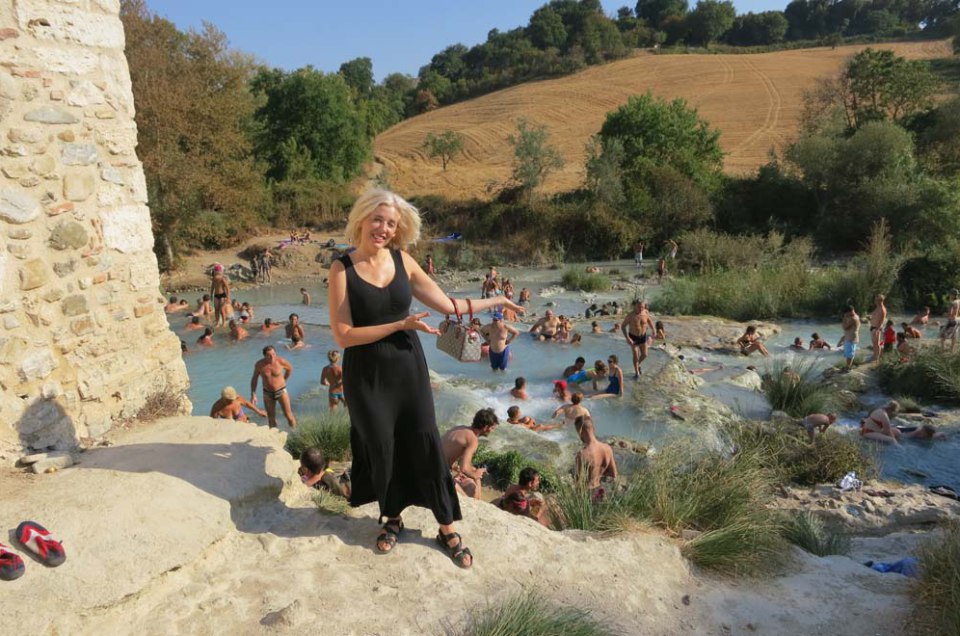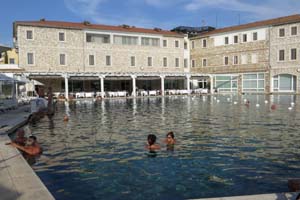“We’re swimming over a volcano,” I said to my fiancé, Mark, as we bobbed around in the water at Terme di Saturnia Spa & Golf Resort, a deluxe retreat in the Maremma region of southern Tuscany.
Beyond the resort, beige fields rolled down the hillsides like runaway bolts of cloth. Cypress trees stood tall against a windless sky. A piece of algae drifted by my nose, another reminder that this may look like a manmade swimming pool, but it’s really a hemmed-in volcanic crater, where the sulphurous water seeps up from the travertine rock floor at a steady 98.6 degrees F. It’s an atmospheric setting for a spa – and a legendary one, too –Saturn himself is said to have created the springs by hurling a lighting bolt into the ground.
Unique as it is, it’s only one of many hot springs destinations in seductive Tuscany, where olive groves and vineyards fuel dreamy visions of the good life with plenty of wine – and plenty of warm thermal springs.
“Saturnia is the Fountain of Youth,” insisted two spry sisters from Bologna who I met in the shady side of the pool the next morning. It was hard to disagree – I could feel the travel stress soaking right out of me. The water, with its high level of dissolved mineral salts and gases, has been attracting the ailing and aching for centuries, and is said to relieve everything from muscle aches and skin conditions to respiratory ailments. At the very least the resort is an upscale place to relax, with an expansive spa that offers everything from traditional mud wraps to high tech facials.
If you’re not staying at the resort, day passes are available for the adjacent pool complex, or you can hang out with the locals further down the road where the water spills over the hillside creating a series of a small terraced pools.
Bagni di Pisa
Just as the resort at Terme di Saturnia was built to take advantage of the hot springs, so was Bagni di Pisa Palace & Spa. Located just outside Pisa, Bagni di Pisa is both imposing and intimate, a pale yellow villa with two outstretched wings. Built in the 18th century as a summer palace for the Grand Duke of Tuscany – a man who appreciated the health benefits of the magnesium-rich water – it opened as a five-star spa hotel in 2004. The A-list guest list, however, goes back to its very beginnings when the duke would invite the aristocratic and literary elite to stay in what is now called the Noblemen’s Hall, a row of stunning guest bedrooms with high frescoed ceilings.
As I sprawled across my velvet bedspread I couldn’t help wondering about the villa’s previous occupants. Two of the duke’s most famous – and scandalous – houseguests were Mary Wollstonecraft Shelley, author of Frankenstein, and her renowned poet husband, Percy Bysshe Shelley – a duo that caused an uproar in Britain after they ran off together while Percy was still married and Mary only sixteen.
Happy to escape a judgemental society back home, the Shelley’s spent much of their time in Italy and Bagni di Pisa must have been a welcome respite. It’s certainly a glamorous one. As I sipped a Campari and soda in the ornate American Bar Shelley with its plush red couches and vaulted ceilings, I couldn’t imagine a more elegant way to spa.
Or to lose weight. In addition to its extensive spa menu and two modest-sized thermal pools, Bagni di Pisa specializes in weight loss programs – so if you can bear to give up that fresh bread drenched in olive oil and extra glass of Brunello, a Weight Loss in Tuscany package might be for you.
Bagno Vignoni
The small town of Bagno Vignoni in the beautiful Val d’Orcia has a long history of spa fans. In the 13th century it was a rest stop for Christian pilgrims en route to Rome, while the bath-happy Romans were here before them and the Etruscans before that. When Mark and I arrived several centuries later, we were surprised to find a fair number of American tourists, lured, no doubt, by the town’s appearance in Frances Mayes book Bella Tuscany.
It’s hard to pinpoint what is so special about Bagno Vignoni. The unpretentiousness? The way the sunshine slants over the hills in the late afternoon? Perhaps it’s the town’s medieval feel. Surrounded by stone buildings, the main square is dominated by a striking thermal basin, centuries old. It might have once been used for bathing, but not today. Modern-day travelers can use the public thermal pools connected to the Hotel Posta Marcucci instead.
Inside, the Hotel Posta Marcucci has an old-fashioned, almost Victorian era feel, while outside you’ll find lawn-covered grounds, side-by-side thermal pools and plenty of deck chairs. Originally Mark and I came just for the afternoon, but like so many other Tuscan spas we visited, the sleepy atmosphere and steamy vapours grabbed hold of our senses and – not for the first time – we couldn’t pull ourselves away.



